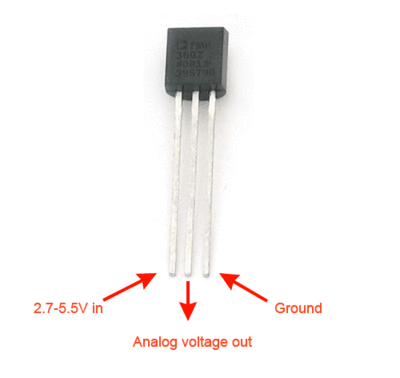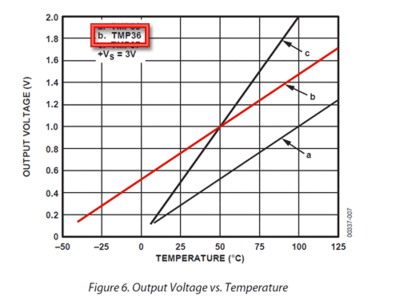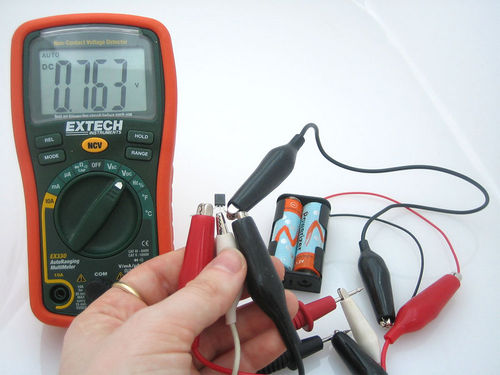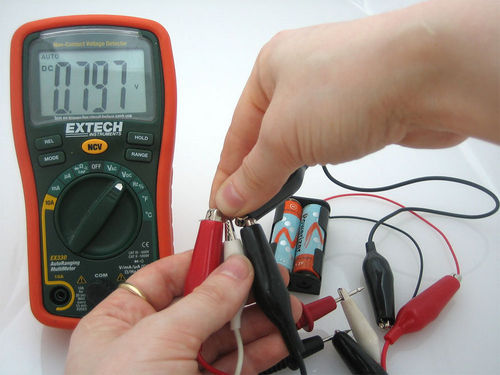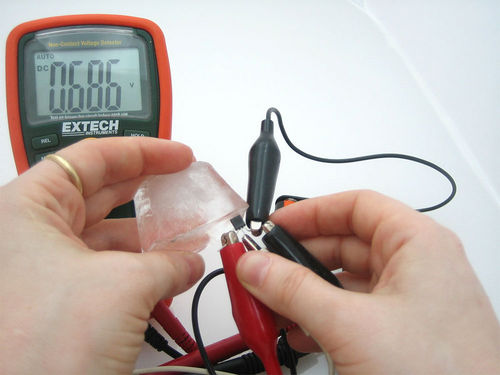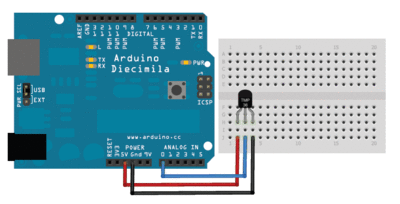Difference between revisions of "Temperature Sensor"
(→Example Project) |
(→Example Project) |
||
| Line 78: | Line 78: | ||
The only one way to read the temperature value from the sensor, and that is plugging the output pin directly into an Analog (ADC) input. | The only one way to read the temperature value from the sensor, and that is plugging the output pin directly into an Analog (ADC) input. | ||
| + | |||
| + | [[File:Tmp36fritz.gif|400px]] | ||
Remember that you can use anywhere between 2.7V and 5.5V as the power supply. For this example I'm showing it with a 5V supply but note that you can use this with a 3.3v supply just as easily. No matter what supply you use, the analog voltage reading will range from about 0V (ground) to about 1.75V. | Remember that you can use anywhere between 2.7V and 5.5V as the power supply. For this example I'm showing it with a 5V supply but note that you can use this with a 3.3v supply just as easily. No matter what supply you use, the analog voltage reading will range from about 0V (ground) to about 1.75V. | ||
Revision as of 15:10, 28 November 2012
Contents
Overview
An analog temperature sensor is pretty easy to explain, its a chip that tells you what the ambient temperature is!
These sensors use a solid-state technique to determine the temperature. That is to say, they don't use mercury (like old thermometers), bimetalic strips (like in some home thermometers or stoves), nor do they use thermistors (temperature sensitive resistors). Instead, they use the fact as temperature increases, the voltage across a diode increases at a known rate. (Technically, this is actually the voltage drop between the base and emitter - the Vbe - of a transistor.) By precisely amplifying the voltage change, it is easy to generate an analog signal that is directly proportional to temperature. There have been some improvements on the technique but, essentially that is how temperature is measured.
Because these sensors have no moving parts, they are precise, never wear out, don't need calibration, work under many environmental conditions, and are consistant between sensors and readings. Moreover they are very inexpensive and quite easy to use.
TMP36 is a wide range, low power temperature sensor outputs an analog voltage that is proportional to the ambient temperature. To use, connect pin 1 (left) to power (between 2.7 and 5.5V), pin 3 (right) to ground, and pin 2 to analog in on your microcontroller. The voltage out is 0V at -50°C and 1.75V at 125°C. You can easily calculate the temperature from the voltage in millivolts: Temp °C = 100*(reading in V) - 50
Specifications
Its very similar to the LM35/TMP35 (celsius output) and LM34/TMP34 (farenheit output). The reason we went with the '36 instead of the '35 or '34 is that this sensor has a very wide range and doensn't require a negative voltage to read sub-zero temperatures. Otherwise, the functionality is basically the same.
- Size: TO-92 package (about 0.2" x 0.2" x 0.2") with three leads
- Temperature range: -40°C to 150°C / -40°F to 302°F
- Output range: 0.1V (-40°C) to 2.0V (150°C) but accuracy decreases after 125°C
- Power supply: 2.7V to 5.5V only, 0.05 mA current draw
- Datasheet
How to Measure Temperature
Using the TMP36 is easy, simply connect the left pin to power (2.7-5.5V) and the right pin to ground. Then the middle pin will have an analog voltage that is directly proportional (linear) to the temperature. The analog voltage is independant of the power supply.
To convert the voltage to temperature, simply use the basic formula:
Temp in °C = [(Vout in mV) - 500] / 10
So for example, if the voltage out is 1V that means that the temperature is ((1000 mV - 500) / 10) = 50 °C
If you're using a LM35 or similar, use line 'a' in the image above and the formula: Temp in °C = (Vout in mV) / 10
Problems you may encounter with multiple sensors:
If, when adding more sensors, you find that the temperature is inconsistant, this indicates that the sensors are interfering with each other when switching the analog reading circuit from one pin to the other. You can fix this by doing two delayed readings and tossing out the first one. Detail can be found at: [1]
Testing a Temp Sensor
Testing these sensors is pretty easy but you'll need a battery pack or power supply.
Connect a 2.7-5.5V power supply (2-4 AA batteries work fantastic) so that ground is connected to pin 3 (right pin), and power is connected to pin 1 (left pin)
Then connect your multimeter in DC voltage mode to ground and the remaining pin 2 (middle). If you've got a TMP36 and its about room temperature (25°C), the voltage should be about 0.75V. Note that if you're using a LM35, the voltage will be 0.25V.
The sensor is indicating that the temperature is 26.3°C also known as 79.3°F
You can change the voltage range by pressing the plastic case of the sensor with your fingers, you will see the temperature/voltage rise.
With my fingers on the sensor, heating it up a little, the temperature reading is now 29.7°C / 85.5°F
Or you can touch the sensor with an ice cube, perferrably in a plastic bag so it doesn't get water on your circuit, and see the temperature/voltage drop.
I pressed an ice-cube against the sensor, to bring the temperature down to 18.6°C / 65.5°F
Example Project
Reading the Analog Temperature Data
The only one way to read the temperature value from the sensor, and that is plugging the output pin directly into an Analog (ADC) input.
Remember that you can use anywhere between 2.7V and 5.5V as the power supply. For this example I'm showing it with a 5V supply but note that you can use this with a 3.3v supply just as easily. No matter what supply you use, the analog voltage reading will range from about 0V (ground) to about 1.75V.
If you're using a 5V Arduino, and connecting the sensor directly into an Analog pin, you can use these formulas to turn the 10-bit analog reading into a temperature:
Voltage at pin in milliVolts = (reading from ADC) * (5000/1024) This formula converts the number 0-1023 from the ADC into 0-5000mV (= 5V)
If you're using a 3.3V Arduino, you'll want to use this:
Voltage at pin in milliVolts = (reading from ADC) * (3300/1024) This formula converts the number 0-1023 from the ADC into 0-3300mV (= 3.3V)
Then, to convert millivolts into temperature, use this formula:
Centigrade temperature = [(analog voltage in mV) - 500] / 10
